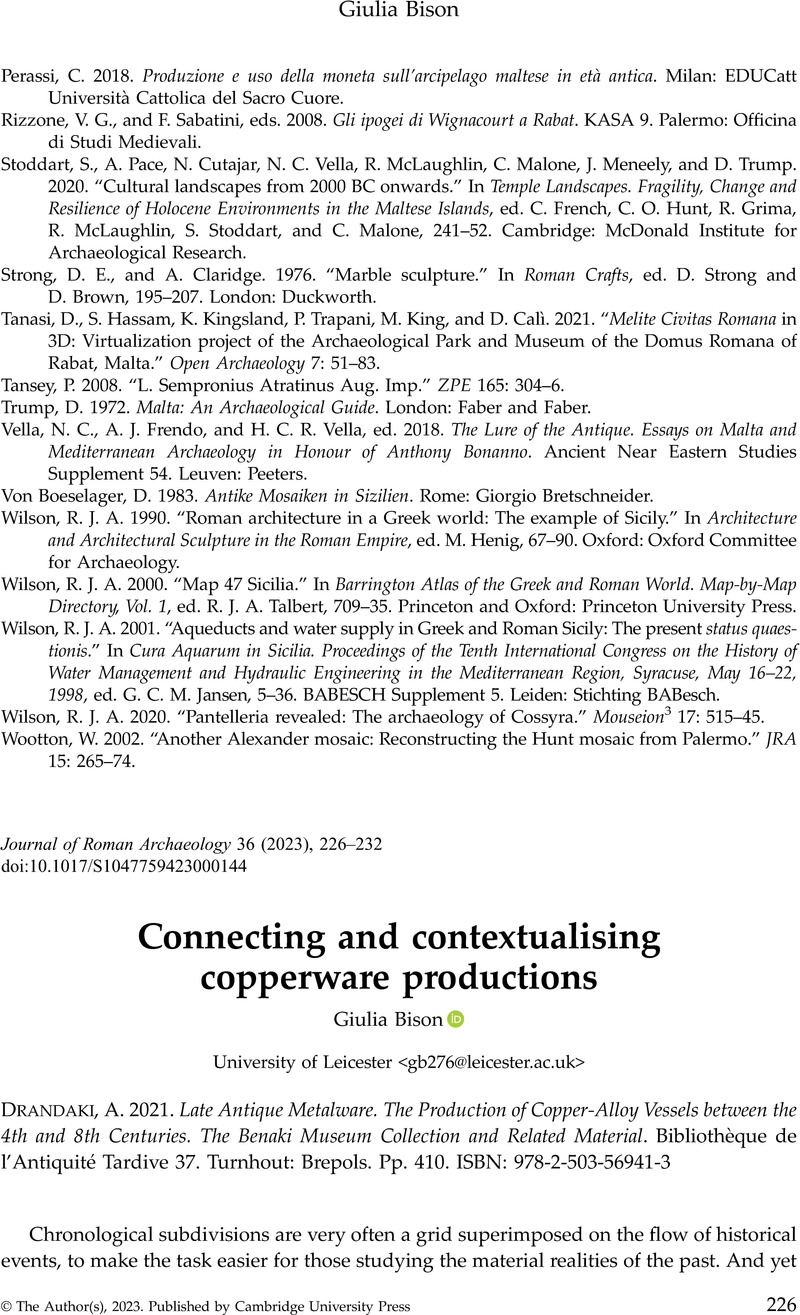No CrossRef data available.
Article contents
Connecting and contextualising copperware productions - A. Drandaki 2021. Late Antique Metalware. The Production of Copper-Alloy Vessels between the 4th and 8th Centuries. The Benaki Museum Collection and Related Material. Bibliothèque de l'Antiquité Tardive 37. Turnhout: Brepols. Pp. 410. ISBN: 978-2-503-56941-3
Review products
A. Drandaki 2021. Late Antique Metalware. The Production of Copper-Alloy Vessels between the 4th and 8th Centuries. The Benaki Museum Collection and Related Material. Bibliothèque de l'Antiquité Tardive 37. Turnhout: Brepols. Pp. 410. ISBN: 978-2-503-56941-3
Published online by Cambridge University Press: 12 May 2023
Abstract
An abstract is not available for this content so a preview has been provided. Please use the Get access link above for information on how to access this content.

- Type
- Book Review
- Information
- Copyright
- Copyright © The Author(s), 2023. Published by Cambridge University Press
References
Artioli, G. 2010. Scientific Methods and Cultural Heritage: An Introduction to the Application of Materials Science to Archaeometry and Conservation Science. Oxford: Oxford University Press.CrossRefGoogle Scholar
Giannichedda, E. 2015. “Casi specifici e considerazioni generali sui tecno-complessi dell'Italia settentrionale.” In L'archeologia della produzione a Roma (secoli V-XV.): atti del Convegno internazionale di studi, Roma, 27-29 marzo 2014, ed. Molinari, A., Spera, L., and Santangeli Valenzani, R., 493–502. Rome and Bari: Edipuglia.Google Scholar
Giumlia-Mair, A. 2002. I Bronzi antichi. Produzione e tecnologia, atti del XV Congresso internazionale (Grado-Aquileia, 2001). Montagnac: M. Mergoil.Google Scholar
Lavan, L. 2007. “Explaining technological change: Innovation, stagnation, recession and replacement.” In Technology in Transition: A.D. 300-650, ed. Lavan, L., Zanini, E., and Sarantis, A. C., xiv-xl. Leiden and Boston: Brill.Google Scholar
Marti-Clerx, V., and Mille, B.. 2002. “Nouvelles données sur la répartition des ateliers producteurs des vases anthropomorphes d’époque romaine: la nature peut-elle déterminer la provenance?” in I Bronzi antichi. Produzione e tecnologia, atti del XV Congresso internazionale (Grado-Aquileia, 2001), ed. Giumlia-Mair, A., 385–92. Montagnac: M. Mergoil.Google Scholar
Pearce, M. 2018. “The curse of the pXRF: The negative consequences of the popularity of handheld XRF analysis of copper-based metal artefacts.” Metalla 24: 81–85.CrossRefGoogle Scholar
Pernicka, E. 2014. “Provenance determination of archaeological metal objects.” In Archaeometallurgy in Global Perspective: Methods and Syntheses, ed. Roberts, B. W. and Thornton, C. P., 239–68. New York: Springer. https://doi.org/10.1007/978-1-4614-9017-3_11.CrossRefGoogle Scholar
Pitarakis, B. 2005. Une production caractéristique de cruches en alliage cuivreux (VIe-VIIIe siècles): typologie, techniques et diffusion. Turnhout: Brepols.Google Scholar
Pollard, A. M., and Bray, P.. 2014. “Chemical and isotopic studies of ancient metals.” In Archaeometallurgy in Global Perspective: Methods and Syntheses, ed. Roberts, B. W. and Thornton, C. P., 217–38. New York: Springer. https://doi.org/10.1007/978-1-4614-9017-3_10.CrossRefGoogle Scholar
Roberts, B. W., and Thornton, C. P.. 2014. Archaeometallurgy in Global Perspective: Methods and Syntheses. New York: Springer.CrossRefGoogle Scholar
Xanthopoulou, M. 2010. Les lampes en bronze à l'époque paléochrétienne. Bibliothèque de l'Antiquité Tardive 16. Turnhout: Brepols.Google Scholar


